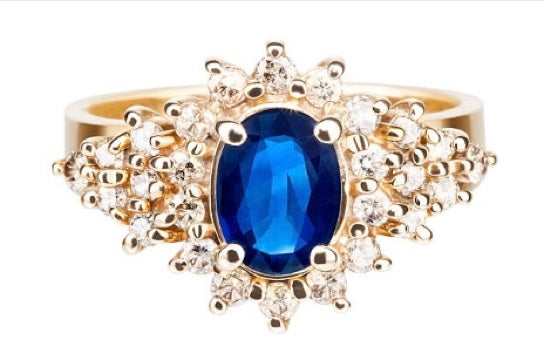
Best Gems for Engagement Rings - A Full Guide
This guide will help clear the confusion by explaining the advantages and disadvantages of different gem types, along with tips on how to care for them. Ready? Let's dive in!
Understanding Gemstone Engagement Rings

Gemstone engagement rings are becoming increasingly popular as a unique and personal alternative to traditional diamond rings.
Benefits and Risks

Choosing a gemstone engagement ring brings benefits such as unique style, larger size, and affordability compared to traditional diamonds. These rings embody personal expression and offer the opportunity to stand out from the crowd.
Moreover, sustainable options like lab-grown stones contribute positively towards environmental concerns. However, risks accompany these rewards. Some gemstones might not withstand daily wear due to their low hardness on the Mohs scale.
For instance, opal and pearl are soft gems that might scratch or break easily. So while considering non-traditional center stones for engagement rings can be desirable, you should also consider potential durability issues before making a final choice.
Importance of Durability

Gemstone engagement rings are chosen for their unique beauty and symbolic meanings. However, the importance of durability is paramount when it comes to picking the perfect stone for your ring.
The Mohs Hardness Scale plays a vital role here as it helps in determining how well a gem can resist scratches and damage - an essential feature considering that this piece of jewelry will be worn daily.
Choosing a durable gem such as sapphires or rubies assures longevity for your precious jewel. These non-diamond gemstones score high on the Mohs Hardness Scale, making them resistant to potential harm from everyday activities.
This resilience not only adds value to your investment but also makes sure that your engagement ring continues to sparkle brilliantly through years of wear and tear.
The Mohs Hardness Scale

The Mohs Hardness Scale serves as a crucial tool for evaluating the hardness of gemstones, influencing their suitability for different types of jewelry. Friedrich Mohs, a German mineralogist, developed this scale in 1812 to measure resistance against scratches.
Diamonds top the rank with an unbeatable score of 10/10, making them exceptionally resistant to damage. However, non-diamond gemstones such like sapphire and ruby also demonstrate impressive durability with a rating of 9/10 on the Mohs Hardness Scale.
Gemstones scoring above 7.5 are considered suitable for everyday wear like engagement ring center stones due to their resilience against potential damages caused by daily activities.
Understanding this scale is essential while choosing durable and long-lasting gemstone engagement rings.
The Top Five Gemstones for Engagement Rings

Engagement rings can shine with a variety of different gemstones. Here is a list of the top five that most couples consider:
- Diamond - Renowned for its unbeatable hardness level at 10/10 on the Mohs Hardness Scale, this traditional choice remains the most popular.
- Sapphire - This durable gemstone scores 9/10 on the Mohs scale, making it resistant to daily wear and tear.
- Emerald - Symbolizing growth and energy, emeralds boast a hardness of 7.5/10.
- Morganite - Its romantic pink hues make morganite a favorite among soon-to-be brides.
- Aquamarine - Representing tranquility and healing, aquamarines also enjoy a durability rating of 7.5/10 on the Mohs scale.
Diamond: The Traditional Choice

Diamonds are the most popular choice for engagement rings due to their timeless beauty and exceptional durability. Find out everything you need to know about diamonds as an engagement ring gemstone.
Features of Diamonds

Diamonds are renowned for their exceptional durability and hardness, making them an excellent choice for engagement rings. These precious gemstones are highly valued for their brilliance, fire, and sparkle, creating a stunning visual effect that catches the eye.
Diamonds come in a range of shapes and cuts, allowing couples to choose one that suits their personal style and preferences. When assessing the quality and value of a diamond, professionals consider the 4 C's - cut, clarity, color, and carat weight.
With their timeless elegance and enduring appeal, diamond engagement rings have long been cherished as symbols of everlasting love.
Pros & Cons of Diamonds

The diamond, with its exceptional durability and radiance, is one of the most coveted gemstones for engagement rings. However, it's vital to weigh the pros and cons to understand the full picture before making a serious investment.
|
Pros |
Cons |
|
Diamonds are known for their extreme hardness and durability, making them resistant to scratches and daily wear and tear. |
Choosing a diamond engagement ring can be a significant financial investment due to their high value. |
|
The brilliance and sparkle of a diamond are unique and unparalleled, giving the ring an exceptional luster. |
Diamonds require special care and cleaning to maintain their sparkle over the years. |
|
Another advantage of diamonds is their availability in a variety of shapes and sizes, enabling customization and personalization. |
There are ethical concerns associated with diamond mining, such as labor exploitation and environmental damage. |
|
A diamond engagement ring is a traditional symbol of everlasting love and commitment, underscoring the significance of the occasion. |
Some may find the traditional aspect of diamond rings to be less unique or individualistic. |
|
The rarity and prestige of diamonds make diamond engagement rings a cherished possession. |
Diamonds can sometimes have internal flaws or inclusions, which can affect their value and appearance. |
Sapphire: A Royal Option

Sapphire, known for its timeless elegance and stunning blue color, is a popular choice for those wanting a touch of royalty in their engagement ring. Find out more about this regal gemstone and why it might be the perfect fit for your special day.
Sapphire Features

Sapphire is a durable gemstone with excellent hardness, making it perfect for everyday wear. With its rich blue color, sapphires are often associated with royalty and elegance. Sapphire engagement rings are a popular choice, featuring the gemstone as a centerpiece surrounded by smaller diamonds or other gemstones.
The quality of a sapphire is determined by factors such as color, clarity, cut, and carat weight. These rings can be customized with different shapes and settings to suit individual preferences.
In addition to their beauty, sapphires are believed to bring good fortune and protection to the wearer.
Pros & Cons of Sapphires

Sapphires offer a beautiful and meaningful alternative to the traditional diamond engagement ring. However, like all gemstones, they have their own set of advantages and disadvantages.
|
Pros |
Cons |
|
Sapphires rank 9/10 on the Mohs hardness scale, making them highly resistant to scratches and damage. |
Unlike diamonds, sapphires may require occasional cleaning and maintenance to maintain their brilliance. |
|
Sapphire engagement rings often come at a more affordable price point than diamond rings. |
Since sapphires are colored gemstones, they may not match with every outfit or piece of jewelry. |
|
Available in various cuts and colors, sapphires offer a range of options to suit individual preferences. |
Certain colors of sapphires may not be easily available or may be more expensive. |
|
Sapphires symbolize loyalty, trust, and wisdom, adding a deeper meaning to the engagement ring. |
As they aren't as popular as diamonds, sapphire engagement rings might not appeal to everyone's taste. |
It's essential to consider these aspects when deciding on whether a sapphire is the right choice for your engagement ring.
Emerald: For a Vintage Appeal

Emeralds offer a vintage appeal with their rich green hue and timeless elegance, making them a popular choice for those seeking a unique and distinctive engagement ring.
Emerald Features

Emeralds are a stunning choice for engagement rings, known for their vibrant green color and timeless beauty. With a hardness rating of 7.5 on the Mohs scale, emeralds are durable enough for everyday wear.
Their unique inclusions add character and create a mesmerizing look that is truly one-of-a-kind. Emerald engagement rings can be designed in various styles to suit individual preferences, from classic solitaires to intricate vintage settings.
Whether you're looking for a touch of vintage appeal or simply love the rich green hue, an emerald engagement ring is sure to make a statement and capture attention wherever you go.
Pros & Cons of Emeralds

Emeralds are indeed a unique choice for an engagement ring, bringing with them a distinct, vintage appeal. Below is a summary of the advantages and disadvantages of choosing an emerald for your engagement ring.
|
Pros |
Cons |
|
Emeralds have a hardness of 7.5/10, suitable for daily wear. |
Emeralds require gentle treatment, as they're susceptible to damage. |
|
The distinct green hue of emeralds offers a unique, vintage appeal. |
Certain inclusions in emeralds, though unique, may not appeal to everyone. |
|
The unique inclusions in emeralds, also known as the "jardin", can make each ring special. |
Emeralds are not as hard as sapphires or rubies, making them less durable. |
|
Many factors such as color, clarity, cut, and carat weight can be considered when selecting an emerald, providing flexibility in choice. |
Emeralds, while beautiful, can be costly, particularly high-grade ones. |

Morganite, with its soft pink hue and romantic charm, is a perfect alternative for those seeking a unique engagement ring. Discover its features, pros, and cons in this section.
Features of Morganite
Morganite is a gemstone known for its romantic and feminine appeal. Its soft, pink hues make it a popular choice for engagement rings. Morganite has a lovely translucent quality that adds a touch of elegance to any ring design.
This gemstone is usually found in larger sizes, which makes it perfect for statement pieces. It's worth noting that while morganite is beautiful, it does require careful maintenance due to its tendency to show dirt and oil easily.
However, despite this drawback, morganite remains an attractive option for those looking for an affordable alternative to diamond rings or other colored gemstones like sapphires or rubies.
Pros & Cons of Morganite
Morganite, a type of beryl stone, is a popular choice for engagement rings due to its romantic pink hue and affordability. However, its lower hardness rating and high maintenance needs may make it less suitable for some individuals.
|
Pros |
Cons |
|
Morganite is known for its pretty pink hue that adds a romantic touch to engagement rings. |
Due to its lower hardness rating, morganite is not as durable as other gemstones, making it prone to scratches and damage. |
|
Compared to diamonds, morganite is more affordable, making it an excellent choice for couples on a budget. |
Morganite shows dirt and oil easily, requiring regular cleaning to maintain its sparkle. |
|
Morganite is a unique and visually appealing gemstone option for an engagement ring. |
It requires proper care and maintenance to prevent damages and to keep its appeal. |
Aquamarine: A Unique Blue Beauty

Aquamarine is a unique blue beauty that adds a touch of elegance to any engagement ring, making it the perfect choice for those looking for something different. Discover its features, pros, and cons to find out if it's the right gemstone for you.
Features of Aquamarine
Aquamarine is a stunning gemstone that makes for an eye-catching engagement ring center stone. With a Mohs hardness scale rating of 7.5/10, it offers the durability needed for daily wear.
Known for its shiny and light blue color, aquamarine symbolizes tranquility and healing. This gemstone is often associated with eternal youth and happiness in marriage. Not only does aquamarine look beautiful on its own, but it also complements various metal types and settings.
Additionally, aquamarine is more affordable than diamonds, making it an appealing choice for those seeking value without compromising style or elegance.
Pros & Cons of Aquamarine
Aquamarine, with its unique blue color and healing symbolism, is a popular choice for engagement rings. However, as with any gemstone, it has its pros and cons.
|
Pros |
Cons |
|
Aquamarine has a hardness of 7.5/10 on the Mohs Hardness Scale, making it a durable choice for engagement rings. |
Over time, the color of aquamarine can fade when exposed to extreme heat or sunlight. |
|
The gemstone's unique blue color represents tranquility and healing, adding a symbolic touch to the engagement ring. |
Aquamarine engagement rings require regular cleaning with mild soap and a soft brush to maintain their brilliance. |
|
Its larger size and unique style come at a lower cost compared to diamond rings. |
Despite its beauty, aquamarine is less traditional than other gemstones, which may not suit everyone's taste. |
Gemstones to Avoid for Engagement Rings

Certain gemstones are not recommended for engagement rings due to their lower hardness rating and lack of durability. When choosing a gemstone for your engagement ring, it is important to consider the following options carefully:
- Opal: Due to its lower hardness rating, opal is more prone to scratching and cracking over time.
- Amethyst: Similarly, amethyst is also not recommended for engagement rings as it can easily get damaged due to its relatively softer nature.
- Tanzanite: With a hardness rating of around 6.5 on the Mohs scale, tanzanite is not as durable as other gemstones and may not withstand everyday wear.
- Pearl: While pearls offer a unique and elegant look, they are not ideal for engagement rings as they are soft and can easily get scratched or damaged.
Caring for Your Gemstone Engagement Ring

Proper care is crucial for maintaining the beauty and longevity of your gemstone engagement ring. Here are some important steps to follow:
- Clean your ring regularly using a mild soap and warm water solution.
- Avoid exposing your ring to harsh chemicals or abrasive cleaners.
- Protect your ring from scratches and damage by storing it in a separate jewelry box or pouch.
- Remove your ring before engaging in activities that may cause impact or contact with hard surfaces.
- Schedule regular professional cleanings and inspections to keep your gemstone secure and shining.
- Consider getting insurance coverage for your ring to protect against loss, theft, or damage.
- Take extra precautions with delicate gemstones like opal and pearls, as they require special care.
- Be mindful of the gemstone's specific properties when caring for it, such as avoiding exposure to sunlight for certain stones.
- If you notice any loose prongs or signs of damage, immediately take it to a trusted jeweler for repairs.
- Follow any additional care instructions provided by the gemstone's manufacturer or supplier.
Conclusion

In conclusion, when it comes to choosing the best gemstones for engagement rings, it's essential to consider durability and personal style. Gems like sapphire and emerald offer timeless beauty and strength with their high hardness ratings.
Aquamarine and topaz provide unique color options while still maintaining durability. Remember to select a gemstone that reflects your personality and values for a truly special engagement ring.
FAQs
1. What are some alternative gems often used in engagement rings?
Non-traditional brides might consider alternative gems like Spinel, Alexandrite, Topaz or Sapphire; even diamonds can come in Fancy Light Yellow or Fancy Vivid Blue.
2. Could you tell me about the durability of gemstones for engagement rings?
Gemstone hardness affects a stone's durability. Durable gemstones like corundum and Chrysoberyl resist scratches and breakages better than softer stones.
3. Are there eco-friendly choices for engagement ring gemstones?
Yes, lab-grown gems including Lab-created diamonds and Moissanites offer an Eco-friendly choice reducing environmental impact compared to mining natural diamonds.
4. How do I ensure that my diamond is ethically sourced?
Blockchain ledger technology helps verify whether your diamond has been ethically sourced.
5. What type of Gem did famous personalities choose for their engagament rings?
Jackie Kennedy had a stunning Cabochon Sapphire whereas Princess Eugenie flaunted a rare pink sapphire ring; Halle Berry showcases a flawless emerald.
6.Can unique features enhance the beauty of my Gemstone engagement ring?
Absolutely! Unique characteristics such as Color Change in Alexandrites, Star effect on Star Sapphires can increase the allure of your handcrafted jewelry or bespoke jewelry designs.


